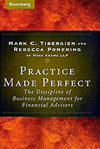Overview: Mark Tibergien and Rebecca Pomering offer a no-nonsense handbook on the management skills critical to running an advisory business whether commission based or fee only.
Tibergien writes, “One of the great ironies of the advisory business is that many of its practitioners-even those who do an excellent job of planning for their clients-do not take the time to strategize, analyze, and plan for their own personal and business success.Effective management is a function of your ability to make decisions, your aptitude for evaluating data, and your commitment to your business model. Good managers have learned how to leverage their organizations so that the business sustains itself rather than depending solely on them.”
The book focuses on three critical disciplines of business management
- human capital management
- strategic planning
- financial management
The goal in discussing these management disciplines is to awaken your management skills and to give you a framework for committing to a strategy and for translating a vision into action. This practical book provides advisors with effective business management techniques.
Authors: Mark Tibergien is the CEO of Pershing Advisor Solutions. In 2005 when this book was published, Mark was the chairman of the Securities and Insurance Niche at Moss Adams, the 11th largest accounting firm in the U.S and has counseled many of the nation’s top advisors. He writes a monthly column for Investment Advisors magazine. Rebecca Pomering is the CEO of Moss Adams Wealth Advisors. When the book was published Rebecca was a principal with Moss Adams, specializes in strategic planning and compensation consulting to the financial advisory industry. At that time she headed Moss Adam’s compensations consulting and benchmarking practice. Their book is published by Bloomberg Press.
Chapter 3: Knowing your Clients: The Value of Surveys
The Client Audit process is a structured approach that provides a customized solution. The survey form is customized and then provided to the advisor for mailing to clients, and the reports are returned to a central processing center. There, the data are evaluated and interpreted and actions steps are developed for the advisor. You’ll want to translate the survey results into an action step or the process will be wasted. (www.advisorimpact.com)
Advisor Impact surveyed thousands of advisors and found that only about 1/3 of advisors survey their clients. The advisors point to a lack of time or expertise as the primary obstacles to conducting a survey although the fear factor tends to top the list of self imposed barriers. The Client Audit gives you the know-how and audit execution.
There was a comprehensive study published in the Harvard Business Review in 2002 which reached some strong conclusions in favor of surveying clients. For most advisory firms, more than 85% of revenue comes from existing clients underscoring the importance of maintaining and growing the relationships that already exist. A properly performed client survey will uncover the following:
Satisfaction
Expectations
Preferences
Interests
Referral propensity
Retention information
Client profile
Client surveys can improve overall client profitability. Properly structured, surveys improve the efficiency, loyalty, time management, and productivity of your professional staff. Surveys can help you identify cross-selling and consolidation opportunities and uncover client expectations. Surveys further demonstrate your value to your clients and justify your fees in a way that helps you to be profitable and fairly rewarded for what you provide.
Time Well Spent?
Julie Littlechild at Advisor Impact examined how much time a typical advisor spends servicing high priority clients, average clients, and low-priority clients. The total time spent dealing with a high-priority client is estimated at 20 hours per year. The typical advisor puts in 1,800 hours in an average work year. So theoretically, the maximum number of high-priority clients the advisor can manage is 90. And that’s assuming the advisor does nothing else and that he has only top priority clients which doesn’t match reality.
The advisor can become more efficient through adding associate-level licensed staff, investing in technology and other tools. These steps can at least keep relationship management within reach. Yet, it is easy for an advisor to grow beyond his ability to provide clients with good service. But he has few methods by which to grow the firm’s income. One of the big hurdles for advisors who choose to work alone is to manage their growth, costs and lifestyle. Once you become known for being really good, everybody wants to do business with you. And it’s very hard to turn away good clients. The solo practitioner has all the challenges of managing staff without the benefits of including other professionals who could challenge them, give depth to their practice, and be another source of revenue and profits for the business.
The Leveraged Model
The leveraged model seems to be the strongest model in terms of driving growth and building capacity, leverage, expertise, and client focus. In this model, the senior financial advisors play a strategic role in client service, while the associates serve a tactical role. The senior financial advisor develops new business and leads discussions about critical planning and implementation decisions the client must make. The associate implements the plans and is the primary day-to-day contact with the client. This team structure can manage two to three times more client relationships than an advisor working alone. This model also provides the context for a career path.
(Insert figure 4.8 page 63 in Practice Made Perfect:
In either model, the clients belong to the business, not to the individual advisors. Compensation to the professional staff team members should be a combination of base salary plus incentives.
Chapter 6: The Care and Preening of Staff: Professional Development
Staff development begins with the definition of performance expectations for the specific position and is further enhanced by the firm articulating its corporate culture. The corporate culture includes the behaviors and values employees must demonstrate. Once you create your ideal corporate culture you must incorporate it into the performance review process and into how you go about selecting new partners or shareholders for the firm. Your corporate culture should also be integrated into your approach to developing human capital.
The Appraisal Process
Employees need and want feedback. Whether he’s the boss or the lowest ranking employee, a person wants and needs to know how others think he’s doing.
What to Evaluate
By employing the discipline of a formal appraisal process, you can evaluate an individual’s specific performance goals for the appraisal period. You can also explore issues important to your culture and use what you learn as a foundation for coaching people to achieve higher levels of performance. The challenge for you is to evaluate all of the other elements that combine to make your culture what it is. Your challenge is to make sure that every person in the organization adopts not just one of the virtues but rather the total concept.
The key is to be clear about what you expect of everyone, know what culture you want to build and sustain, and have a means for evaluating and reinforcing the right behavior. Should you choose to ignore all of the soft issues and focus solely on making money; that is a clear statement of culture.
Hiring your Boss: Do You Need a CEO?
In the 2003 Compensation and Staffing Survey conducted by Moss Adams for the Financial Planning Association, we found that 52% of firms that generate more than $1 million in annual revenues employ the services of a CEO. Clearly, every growing business needs a leader who will provide strategy and planning and who has executive management skills to translate that vision into action-whether or not that person is a professional CEO.
It is difficult for most owners of advisory firms to give up the strategic leadership role in their business. Depending on the size of the firm, the position could be a general manager or a chief operating officer (COO). The key concept is that the manager makes sure the infrastructure of the firm is operating efficiently, effectively, and productively.
At this point, your challenge is to decide whether you should serve in the management role, the leadership role, or both. If your time is better spent on client services or on business development, then try not to let your ego get in the way of effective management. If the role is not for you, come clean and focus your talents where you can make the greatest impact on your business. But if you engage professional management or delegate these duties to others within your firm, you may need to work on keeping your reactions in check. If you hired well and were clear about your expectation, you’ll be far better off allowing your managers to do their jobs than to insinuate yourself into the minutiae of their decisions.
Staff Expectations
Tibergien often sees a disconnect between how the manager and the employee define the job and value the contribution, particularly when the employee is still in the process of building his or her skills.
The Components of Compensation
The five components are base pay, bonuses and incentives, benefits, perquisites and long-term wealth building.
Establishing Base Compensation
Setting base compensation can be a challenge. The process begs the question, What is market-rate compensation? The biannual FPA Compensation and Staffing Study provides benchmarks unique to the advisor market. You want to consider what it would cost to hire someone else to perform the employee’s job. Don’t ask, “What is the candidate worth?” but rather “What is the job worth?” and “What is this candidate worth in this job?”
Establishing and Incentive Compensation Plan
There is a difference between a bonus and an incentive. A bonus is a surprise. An incentive is tied to some measurable expectation. The role incentive compensation plays will vary by firm and usually by position within a firm. Those positions that have greater influence on the success of the business typically have more compensation at risk. Incentive plans tend to be moving away from strictly revenue-based drivers and working to incorporate additional measures such as new clients in a target market and total firm revenue. Be sure to communicate the underlying philosophy and avoid getting caught in the mechanics of the plan.
The Role of Equity Participation
Many firms with an eye on succession planning are examining the role of equity or other long term wealth accumulation in the overall compensation scheme. Equity plans should be reserved for those individuals who behave like owners and whose contributions to the business result in enhanced value. Equity participation may be real – in the form of options, partnership, or other stock ownership- or it may be in the form of phantom stock. Real equity should always be sold, rather than given away, and the criteria for becoming an owner should be well deliberated.
Owner’s Compensation
Owners of advisory firms should be compensated like any other person for their role as employees of the business: base compensation for the job they do and incentive compensation for exceeding expectations. And they should be held to the same performance expectations and evaluation process as any employee doing the same job. The third component of compensation, ownership distribution, is the piece that distinguishes owners from others who do the same job. This piece of compensation rewards the owners for the risk inherent in running a small business and should be evaluated against returns for other investments of similar risk. This allows the owners to differentiate contributions made by different partners at different phases in their careers.
Gross Profit Margin
Learning how to manage gross profit margin will probably be the single most important financial-management discipline you can apply to your practice. When profitability is declining, most financial advisors tent to cut costs. But cutting costs will do nothing to improve pricing or productivity or client mix.
If the gross profit margin is declining, the cause may be any on of five problems:
- Poor pricing
- Poor productivity
- Poor payout
- Poor client mix
- Poor service/product mix
Poor pricing-As an owner, you need to answer some key questions: Do you know how much it costs you to deliver that service or to ser that client? Do you view that service as a loss leader or as a way to enhance your profitability?
Poor productivity-Tibergien provides some key ratios to analyze the performance of those who are developing business and advising clients. You need to observe trends. Three of the ratios he suggests to measure productivity are increases in revenue per client or revenue per staff, and clients per professional staff. He suggests a number of ratios on page 171.
Consider your client mix-Tibergien challenges the widely accepted Pareto axiom, the 80/20 rule. He poses, why would advisors tolerate having 80% of their business so far off their “sweet spot” or target market.
Evaluate your product and service mix-Advisors tend to add services as a favor to a client or in reaction to a perceived opportunity, but the service may not fit comfortably into the firm’s existing structure. Employ your business strategy as your decision-making tool to ensure that the products and services you offer are in line with your overall strategy you have committed to.
Examine your compensation practices-Are they suited to your market? Are you getting an adequate return on this investment? Do you know what the value of your time is? Or the value of your staff’s time?
Chapter 10: Referrals and Joint Ventures: The Search for Solutions
The most common strategies advisors use to create business are referral agreements and joint ventures, practice acquisitions, and investments in new initiatives.
Referral Agreements and Joint Ventures
Joint ventures and referral agreements should not be confused with buildings one’s referral network or developing informal alliances. In a referral agreement, two parties formally combine their strengths to shor up each other weaknesses and systematically capture more business. The referral agreement model works best when both parties share in the risk and return, the vision is clearly stated, and the economics are right for your business.
Practice Acquisitions
- The challenges of practice acquisitions:
- Not enough potential future income per client.
- Clients who are too old.
- Price based on rule of thumb.
- Insufficient cash flow to support the purchase.
- Lack of capacity
Practice acquisition is a viable growth strategy provided you invest in due diligence and critical financial analysis. You should consider these questions:
- How independent is the source of the deal? Have an independent professional skilled in mergers and acquisitions review the deal.
- Can the practice reward me for both my labor and my risk?
- Is there a more effective way to deploy me resources?
- Is the acquisition a good culture fit?
- Do I have the capacity to serve this client base?
- Have I evaluated all of the hidden risks?
<div class="divide-page-after" style="background-position: center; height: 5px; clear: both; border-top-color: rgb(153, 153, 153); border-bottom-color: rgb(153, 153, 153); border-top-width: 1px; border-bottom-width: 1px; border-top-style: dotted; border-bottom-style: dotted; float: none; display: block; background-image: none;" system="" no-repeat;"="" dividepagepsg.gif?t='B8DJ5M3");' images="" pagespliter="" plugins="" ckeditor="" cms="" www.riamatch.com="">
Investments in New Initiatives
Questions to ask when considering a new initiative are: What is a reasonable return on my investment for these new initiatives, and when should the return be realized? The amount of return will vary, but you should attempt to calculate how much business you would need to do to generate both a return on the investment and a reasonable return for the risk you are taking. It is generally a good idea to establish a time horizon of eighteen to twenty-four months within which you’ll begin realizing a return. That horizon is relatively short, but the length is dictated by the nature of these investments, which are often geared to producing a return in a short time.



